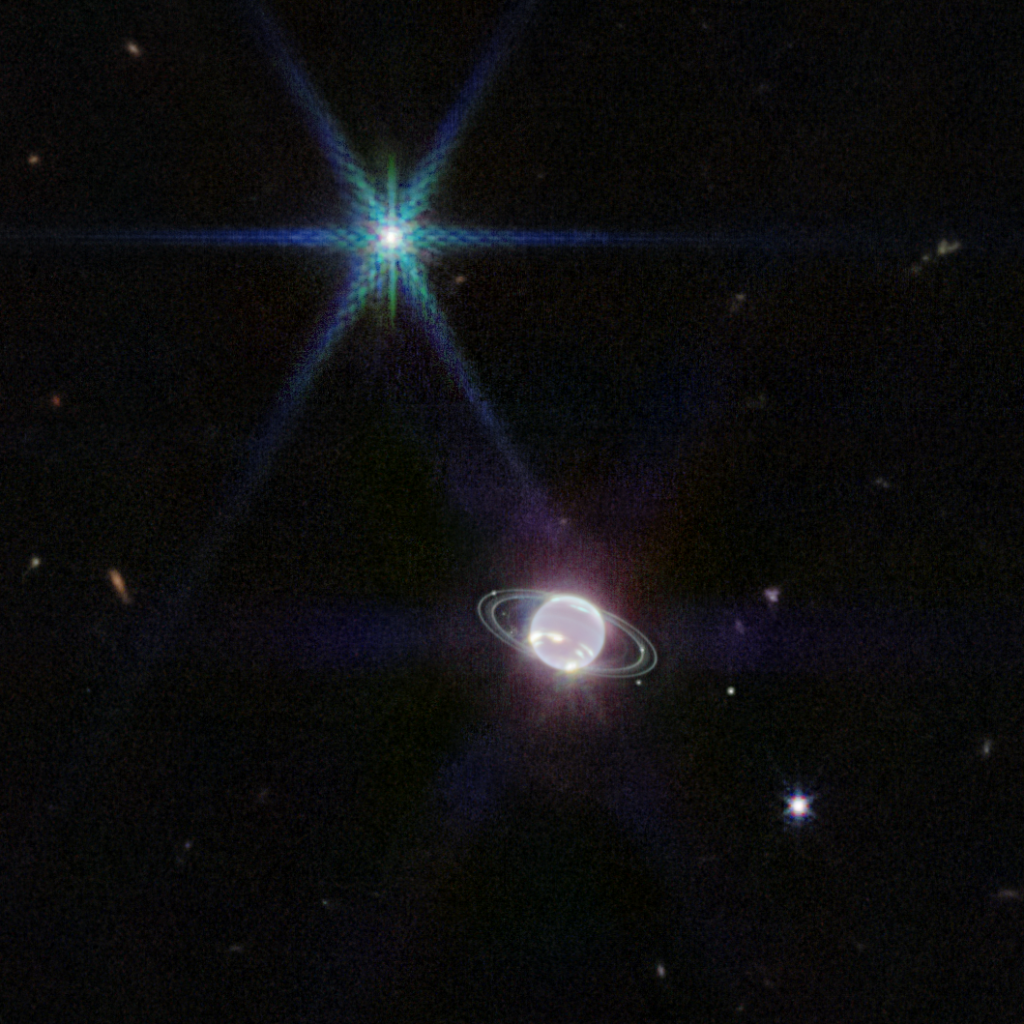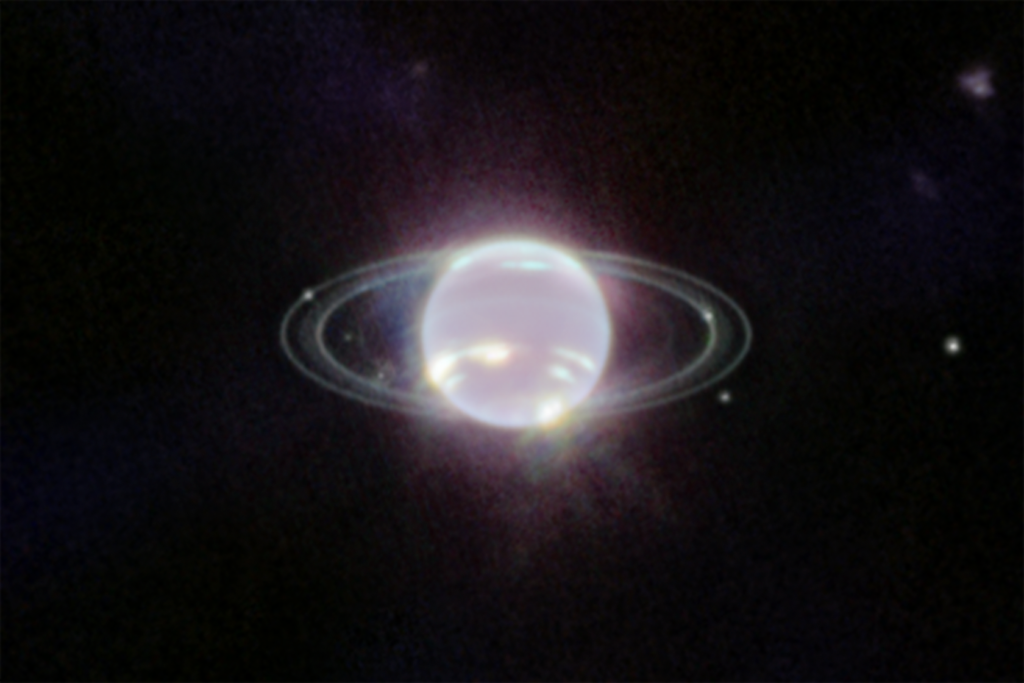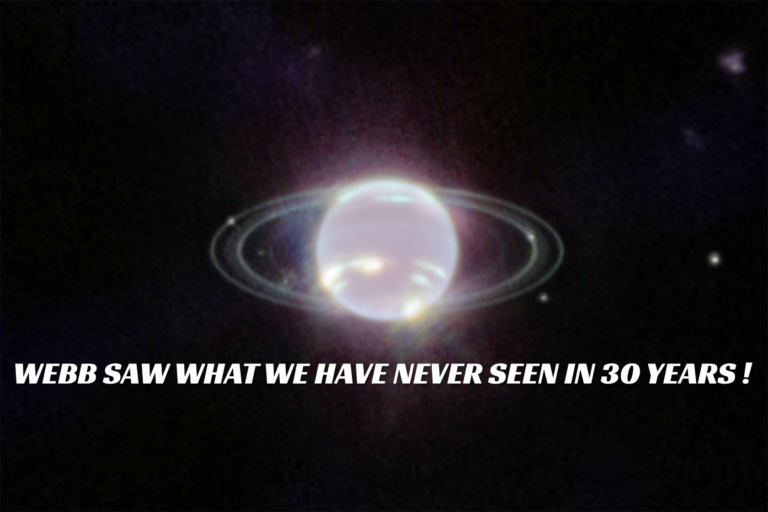The clearest view of Neptune’s rings in decades is captured by a new Webb image.
With its first image of Neptune, NASA’s James Webb Space Telescope displays its capabilities closer to home. In addition to providing the best glimpse of the planet’s rings in more than 30 years, Webb’s cameras also shed fresh insight on the ice giant.
The clarity of the planet’s rings, some of which have not been seen since NASA’s Voyager 2 became the first spacecraft to examine Neptune during its approach in 1989, is what stands out most in Webb’s latest photograph. The Webb image vividly displays Neptune’s fainter dust bands in addition to many brilliant, thin rings.
According to Heidi Hammel, a Neptune system specialist and transdisciplinary scientist at Webb, “It has been three decades since we last observed these weak, dusty rings, and this is the first time we have seen them in the infrared.” These incredibly weak rings were discovered so near to Neptune because to Webb’s exceptionally consistent and accurate image quality.

Credits: NASA, ESA, CSA, STScI
Since it was discovered in 1846, Neptune has captivated scientists. Neptune orbits in the distant, dark area of the outer solar system, 30 times further from the Sun than Earth. High noon on Neptune is comparable to a dull twilight on Earth because to how tiny and pale the Sun appears from such a great distance away.
The internal chemical composition of this planet qualifies it as an ice giant. Neptune is substantially richer in elements heavier than hydrogen and helium than the gas giants Jupiter and Saturn. Small concentrations of gaseous methane enable Neptune to appear characteristically blue in Hubble Space Telescope photos at visible wavelengths, which is easily observable.
Neptune does not seem blue to Webb because his Near-Infrared Camera (NIRCam) only sees objects in the near-infrared spectrum between 0.6 and 5 microns. In reality, the planet is fairly black at these near-infrared wavelengths due to the substantial absorption of red and infrared light by methane gas, with the exception of areas with high-altitude clouds. These brilliant streaks and patches of methane-ice clouds are noticeable because they reflect sunlight before it is absorbed by methane gas. Over the years, images from other observatories, including as the W.M. Keck Observatory and the Hubble Space Telescope, have captured these fast changing cloud structures.

Credits: NASA, ESA, CSA, STScI
A more discrete visual indicator of the worldwide atmospheric circulation that fuels Neptune’s winds and storms might be a narrow line of light ringing the planet’s equator. At the equator, the atmosphere lowers and heats, making it light at infrared wavelengths more than the nearby, colder gases.
Neptune’s northern pole, near the top of this image, is barely out of sight for astronomers due to its 164-year orbit, but the Webb photos suggest an unusual brightness there. Webb’s image clearly shows a previously known vortex around the southern pole, but this is the first time Webb has shown a continuous ring of high-latitude clouds encircling it.
Seven of the 14 known moons of Neptune were also caught by Webb. A very brilliant point of light with the distinctive diffraction spikes observed in many of Webb’s photographs dominates this Webb painting of Neptune, however this object is not a star. This is Triton, the big and strange moon of Neptune.
Triton reflects around 70% of the sunlight that it receives thanks to a frozen coating of condensed nitrogen covering it. Because methane absorbs at these near-infrared wavelengths, it outshines Neptune by a significant margin in this photograph. Triton’s peculiar retrograde orbit around Neptune has led scientists to hypothesize that this moon was once a Kuiper belt object that was gravitationally grabbed by Neptune. In the upcoming year, further Webb observations of Triton and Neptune are anticipated.
The best space scientific observatory in the world is the James Webb Space Telescope. In addition to looking beyond our solar system to distant planets orbiting other stars, Webb will delve into the enigmatic architecture and origins of the cosmos and our role within it. An multinational project called Webb is run by NASA in conjunction with the Canadian Space Agency and the European Space Agency.
Source:NASA
The James Webb Space Telescope‘s Near-Infrared camera (NIRCam) captured stunning imagery of Neptune. It is the “clearest view of this peculiar planet’s rings in more than 30 years,” according to ESA/NASA.
Do not forget to share your opinion with us to provide you with the best posts !





0 Comments